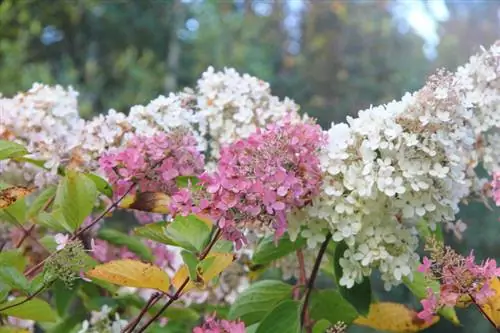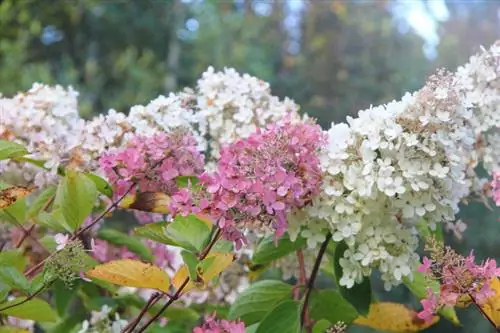- Author admin [email protected].
- Public 2023-12-16 16:46.
- Last modified 2025-06-01 06:02.
The need or desire to transplant panicle hydrangeas can have various causes. Be it because the location turned out to be less than ideal, the plant was planted too close together or even construction work or a move is imminent. As a rule, panicle hydrangeas that have not been in one place for more than five years can be transplanted without any problems.

How to transplant a panicle hydrangea?
To successfully transplant a panicle hydrangea, choose the period after flowering from October to the onset of frost. Carefully dig up the plant, trimming back broken roots and reducing above-ground parts if necessary. Plant the hydrangea in loose potting soil at the new location.
The right time for transplanting
The ideal time for transplanting panicle hydrangeas is after flowering from October until the onset of frost. If necessary, early spring is also an option. However, spring is considered to be of little use for such an action because the plant has to make much greater efforts than in autumn: after all, it not only has to develop new roots, but also new shoots. If you transplant it in the fall, however, it will have enough time to grow vigorously again in its new location.
Transplanting - The step-by-step instructions
The primary goal of any transplanting campaign should be to get as many fine roots as possible out of the ground undamaged. That's why you can create a hand-width trench around the plant in the summer before the actual transplanting, which you fill up with loose potting soil. This measure promotes the formation of many new fine roots in the ball area. When moving it yourself, proceed as follows:
- Carefully dig the plant free.
- Put the spade as deep as possible on the roots.
- Now lift the panicle hydrangea with the ball of soil out of the hole.
- Cut back broken roots before replanting.
- Similarly, above-ground parts should be cut back.
- Otherwise, the remaining roots cannot adequately supply the rest of the plant.
- It is therefore best to combine transplanting with annual pruning.
- Now the mover as well as freshly purchased young plants are planted at the new location.
- The formation of new roots is promoted by adding loose potting soil.
Tips & Tricks
Pranicle hydrangeas transplanted in late fall can be so stressed in very cold winters that they can die. That's why, as soon as the temperatures get too frosty, it's better to play it safe and provide the plant with winter protection, e.g. B. by covering it with coconut or straw mats. In addition, the root area in particular should be protected with a thick layer of mulch.






